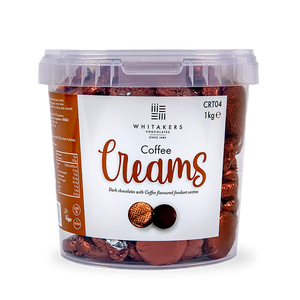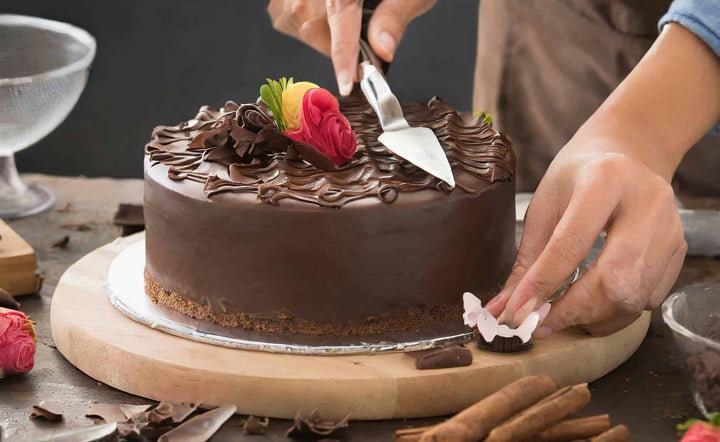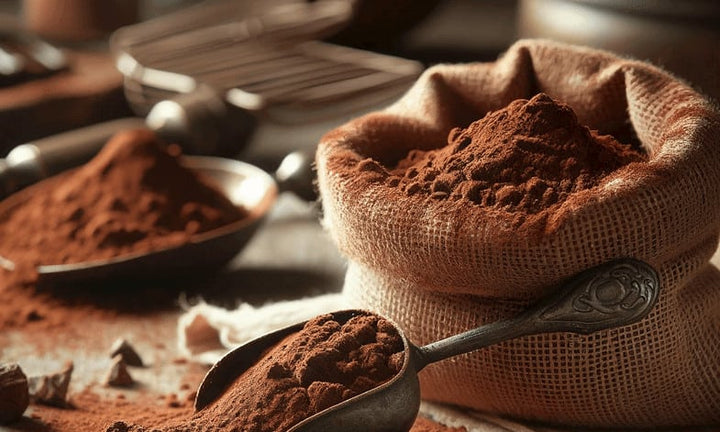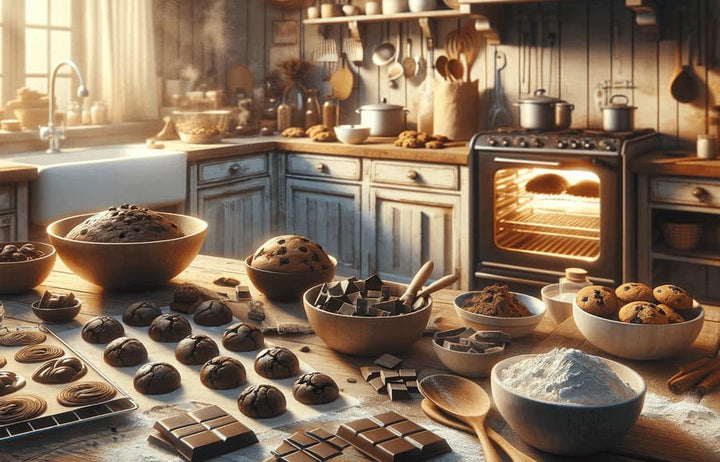At first glance, melting chocolate might seem to be a simple undertaking.
But take it from an expert; it's somewhat more complicated than it initially seems!
With extensive experience handling liquid chocolate daily, here at Whitakers, we have gained valuable insights.
That's why we've compiled this infallible guide featuring top advice and techniques for melting chocolate, enabling you to indulge in luscious, melted goodness.
Continue reading to master the art of melting chocolate like a true professional!
How to Melt Chocolate (Without Ruining It!)
The process of melting chocolate is more intricate than it may initially appear. In a nutshell, the sugar content in chocolate is what makes melting it challenging.
The presence of even a single contaminant can cause the chocolate to "seize," resulting in the sugar forming a syrup with other components, ultimately creating a large, lumpy disaster.
Overheating the chocolate too rapidly can also trigger this issue. Therefore, my advice is to approach the melting process with patience and avoid rushing through it
While all chocolate varieties can be melted, certain types are more suitable for your melted chocolate recipes.
The primary distinction lies in how various chocolate types harden after melting and the significance of this factor in your recipe.
One possible issue is the cocoa butter separating from the chocolate, resulting in an odd grey hue on the surface of your creation and also inhibiting a satisfactory 'snap'.
Top tip: By opting for chocolate with a high cocoa butter content, you can undergo a tempering process that helps prevent issues like separation and discolouration.
(Click here if you want to learn how to temper chocolate).
When baking with chocolate, tempering is not necessary, and you can also purchase pre-tempered chocolate pieces to facilitate the process.
To find chocolate with a high cocoa butter content, search for the word "couverture".
(What is couverture chocolate? Click the link to find out).
It is also essential to pay attention to your percentages with chocolate: anything in the 55-70% range will be best for melting and coating.
Keep in mind that chocolate comes in many forms.
Most markets will carry chocolate bars, callets and chocolate shards, so make sure you choose the right type for your specific recipe.
We have developed Easymelt, which is perfect for melting down.
This comes as a 55% dark chocolate ‘couverture’ in mini shards specifically designed for melting.
Now that you have chosen your chocolate, you are ready to start melting!
But remember to take your time. The process of melting chocolate is not one to be rushed!
Before you start, ensure all surfaces and equipment are completely dry; any water can ruin chocolate melting instantly!
(Click here if you would like to learn: How to Make Melted Chocolate Thinner)
How To Melt Chocolate In a Microwave
Using a microwave is probably the most popular method of melting chocolate.
This technique can be challenging if not executed properly. The secret lies in proceeding slowly.
Although it might take 30-45 seconds in the microwave to completely melt your chocolate, you should avoid setting it for 30 seconds straight.
Upon opening the microwave, you might encounter a large, lumpy mess rather than the smooth, velvety chocolate you desired.
The optimal approach for microwaving chocolate involves heating it in 10-15 second intervals and stirring in between, particularly when the edges begin to melt.
Be sure to mix the chocolate with a spatula during each interval to avoid burning.
Chocolate generally maintains its form well into the melting process, so stirring will provide a more precise indication of the actual melted state of your chocolate.
Related: Making Chocolate Shards.
How To Melt Chocolate in a Pan
- Fill your saucepan with one inch of water and place on a high heat.
- Place a metal/heat-proof bowl filled with your chocolate over the saucepan (make sure your bowl doesn’t touch the water).
- Heat the water in the saucepan to a boil before immediately turning it down to a gentle simmer.
- If the heat is too high, the chocolate may burn and create clumps, so make sure there is a gentle heat warming the chocolate.
- Stir continually with a rubber spatula as the chocolate starts to melt.
- There will be steam coming up the sides of the bowl, so it’s essential to make ensure that no water mixes into the chocolate—water and chocolate don't mix well. Water will immediately make the chocolate go all clumpy.
- When the chocolate has melted, take it off the heat and remove the bowl from the pan.
- Next, you should wipe the bottom of the bowl with a dry and absorbent cloth to remove any water.
- You are ready to use your melted chocolate!
(You might also like to read this post about how to fix seized chocolate).
How to Melt White Chocolate
You may not know this, but white chocolate isn’t really chocolate!
Instead, it’s a mix of milk, sugar, cocoa butter, vanilla flavouring and some fat.
Therefore, it doesn’t melt as easily as milk or dark chocolate.
White chocolate also burns quite quickly, so it’s important to melt it using indirect heat - otherwise, you will be left with a clumpy, unusable mess!
There are two methods you can adopt when trying to melt white chocolate, either using a double boiler or a microwave.
Using a Double Boiler to Melt White Chocolate
- Fill your saucepan with one inch of water and place on high heat.
- Place a metal/heat-proof bowl filled with your white chocolate over the saucepan (make sure your bowl doesn’t touch the water).
- Heat the water in the saucepan to a boil before immediately turning it down to a gentle simmer.
- If the heat is too high, the white chocolate may burn and create clumps, so make sure there is just a gentle heat warming the chocolate.
- Stir the chocolate continually with a rubber spatula as the chocolate starts to melt.
- There will be steam coming up the sides of the bowl, so it’s essential to make ensure that no water mixes into the chocolate—water and chocolate don't mix well. Water will immediately make the chocolate go all clumpy.
- When the chocolate has melted, take it off the heat and remove the bowl from the pan.
- Next, you should wipe the bottom of the bowl with a dry and absorbent cloth to remove any water.
- You are ready to use your melted chocolate!
Using a Microwave to Melt White Chocolate
- Place white chocolate chunks or white chocolate bar broken into pieces into a microwave-safe bowl.
- Heat no more than 20 seconds at a time.
- Each time you heat the chocolate, take it out of the microwave and stir.
- Continue to heat and stir until the white chocolate is fully melted—remember, it is easy to burn white chocolate.
- Once you have a bowl full of lovely melted white chocolate (with no clumps), you’re ready to use it!
What Temperature Does Chocolate Melt?
Different types of chocolate have different melting points.
For example, dark chocolate should be melted between 120 and 130°F (50°C and 55°C), while milk and white chocolate should melt at around 105-115°F (40-45°C).
Is it Better to Melt Chocolate in a Pan or Microwave?
There is no right or wrong answer to this. It’s just down to personal preference. Both have their pros and cons.
Although using a microwave may offer a faster solution, opting for a double boiler and melting the chocolate on the stovetop guarantees that it won't burn.
This approach leads to uniformly melted chocolate with a luxuriously smooth texture.
Why Would You Melt Chocolate?
Why wouldn’t you melt chocolate?!?
It’s delicious and so versatile. Have you ever heard of a chocolate fountain?
A chocolate fountain consists of melted chocolate cascading seamlessly from its peak, often accompanied by an assortment of delectable items for dipping, such as marshmallows, strawberries, and rice Krispie treats, among others.
Still not convinced? Melting chocolate may be essential when preparing various baked delights like brownies, soufflés, icings, or even crafting chocolate truffles.
It's undeniable that chocolate is delightful in any form; however, the process of melting it unveils a distinct, luscious texture that sets it apart!
Moreover, when attempting to create the ultimate chocolate cake, melting the chocolate can help achieve the ideal consistency for coating or decorating purposes.
Regardless of the motivation behind melting chocolate, we firmly believe it's a justifiable one!
What is the Best Chocolate for Melting?
There are many different types of chocolate on the market, from bittersweet, semi-sweet, dark, milk and white chocolate.
New to the market is caramel or ruby, although these don’t tend to be as popular as dark, milk and white chocolate varieties.
So choosing the right chocolate can be a bit of a minefield, but if you’re following a recipe, it should state what chocolate to use.
As mentioned above, all chocolate will melt. It’s just that some are better than others.
For us, dark chocolate is our preferred choice (sometimes referred to as plain chocolate in recipe books).
It’s important to pay attention to your percentages with chocolate. Anything in the 55-70% range will be best for melting and coating.
Though getting the right chocolate is important, remember that this only really matters for treats you can see the chocolate in, for instance, for a coating or a dip.
If you are using chocolate chips to make a brownie, then you would be fine using untempered chocolate. In fact, just about any type of chocolate will do.
But if you are dipping or coating anything, then tempering chocolate or buying pre-tempered chocolate is essential.
Check out our dark 55% chocolate couverture mini shards, ‘Easymelt’, specifically made for melting, dipping, covering or adding flavour to your recipes.
What is the Best Way to Harden Chocolate After Melting?
Either leave the melted chocolate in a cool room to harden or place the chocolate in a fridge if you want to speed the process up.
As a rule, at room temperature, chocolate will take 20 – 30 minutes to harden and set. But, of course, using a fridge or freezer will take much less time.
(You might also want to read this post: Should You Put Chocolate in the Fridge or Freezer?)
Final Notes on Melting Chocolate
We hope we have covered all the points relating to the question of how to melt chocolate.
Whilst it can be daunting, the main point to remember is to take your time and allow the chocolate to melt gently (and keep stirring!).
If you’re using the microwave method, ensure you’re doing short bursts at a time and stirring the chocolate each time you remove it from the microwave.
Have fun experimenting, and share your triumphs and disasters with us!
Please tag us in #whitakerschocolates (always with just one “T”) if you share any photos anywhere on social media.






















